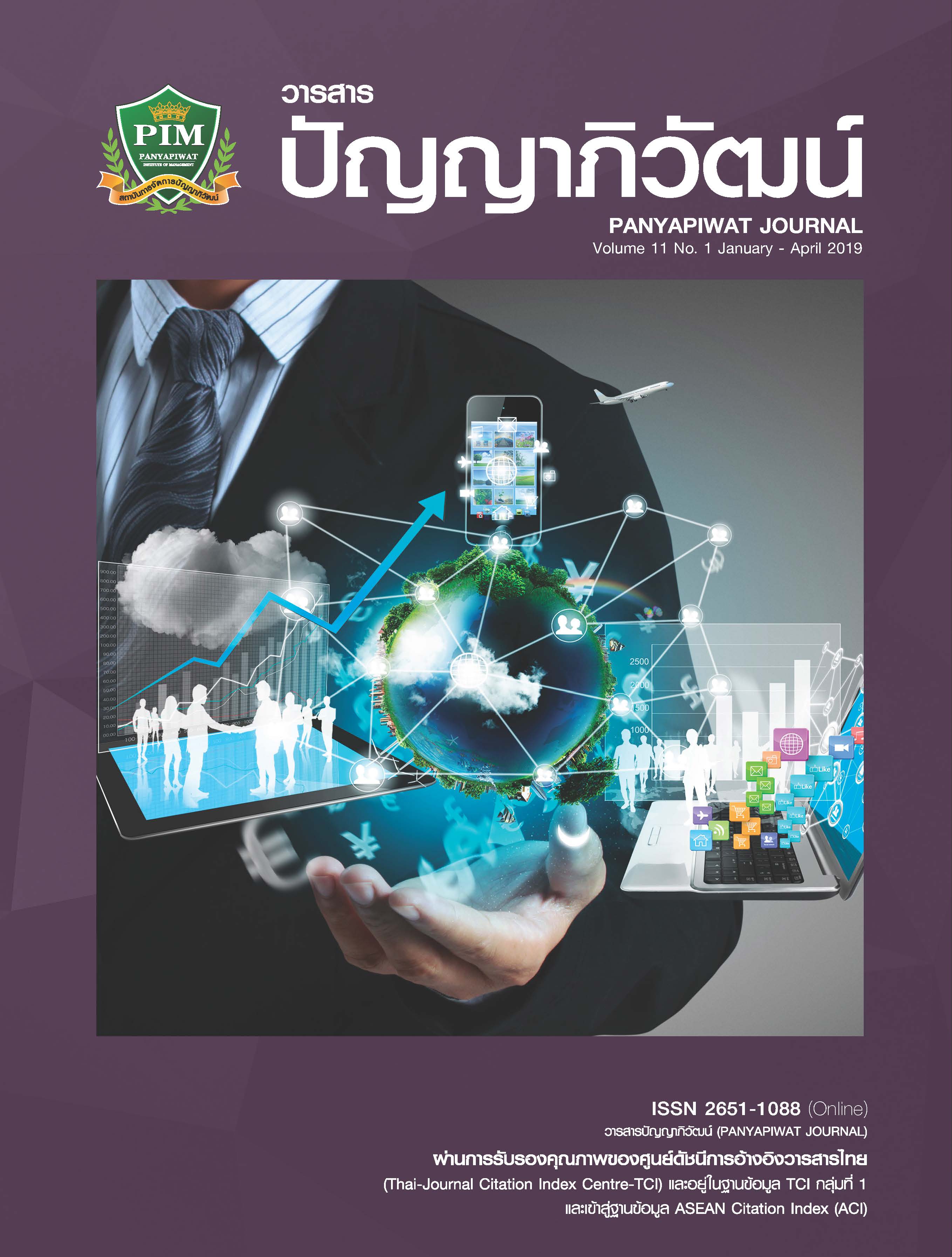A CAUSAL MODEL OF FACTORS INFLUENCING FIRM SUCCESS OF HOTEL BUSINESSES IN THAILAND
Main Article Content
Abstract
The objectives of this research were to analyze the relationships of causal factors including: 1) to study the causal effects of transformational leadership, learning culture and competitive capability on the firm’s success; 2) to study the causal effects of transformational leadership and
learning culture on competitive capability; and 3) to investigate the congruence of the causal model of factors influencing the success of hotel business in Thailand. The samples were 311 hotel business organizations in Thailand. The employed research instrument was a questionnaire with
factor loadings between .861–.938 and Cronbach alpha between .869–.936. Structural equation modeling was used to analyze this data.
The results show that 1) competitive capability have a direct effect on the firm’s success, while transformational leadership and learning culture do not have direct effect on the firm’s success but have indirect effects on the firm’s success through competitive capability; 2) transformational leadership and learning culture have direct effects on competitive capability; as for the causal relationship model, results of data analysis show that the model has goodness-of-fit with the empirical data (χ2/df = 1.46, p = .053, CFI = .995, TLI = .993, RMSEA = .033, SRMR = .014).
Article Details
I and co-author(s) certify that articles of this proposal had not yet been published and is not in the process of publication in journals or other published sources. I and co-author accept the rules of the manuscript consideration. Both agree that the editors have the right to consider and make recommendations to the appropriate source. With this rights offering articles that have been published to Panyapiwat Institute of Management. If there is a claim of copyright infringement on the part of the text or graphics that appear in the article. I and co-author(s) agree on sole responsibility.
References
Agoda. (2016). Agoda.com–Agoda Thailand. Retrieved March 15, 2016, from https://www.agoda.com/th-th/country/thailand.html [in Thai]
Bangkokbiznews. (2016). Special Articles: Hotel business intense competition 2016. Retrieved March 15, 2016, from https://www.bangkokbiznews.com/blog/detail/640668 [in Thai]
Bass, B. M. & Avolio, B. J. (1995). Multifactor leadership questionnaire: manual for research. Redwood City, CA: Mind Garden.
Bollen, K. A. (1986). Sample size and bentler and Bonett’s normed ft index. Psychometrika, 51(3), 375-377.
Bontis, N. (1999). Managing an organizational learning system by aligning stocks and flows of knowledge: an empirical examination of intellectual capital, knowledge management, and business performance. Hamilton: Management of innovation and new technology research centre.
Bunnoon, P. & Ussahawanitchakit, P. (2012). Proft planning effciency, goal achievement, and frm success: evidence from canned foods business in Thailand. Journal of International Business and Economics, 12(4), 1-16.
Dustin, G., Bharat, M. & Jitendra, M. (2014). Competitive advantage and motivating innovation. Advances in Management, 7(1), 1-7.
García-Morales, V. J., Jiménez-Barrionuevo, M. M. & Gutiérrez-Gutiérrez, L. (2012). Transformational leadership influence on organizational performance through organizational learning and innovation. Journal of Business Research, 65(7), 1040-1050.
Hair, J. F., Black, W. C., Babin, B. J. & Anderson, R. E. (2010). Multivariate data analysis (7th ed.). New Jersey: Pearson Education.
Hair, J. F., Anderson, R. E., Tatham, R. L. & Black, W. C. (2006). Multivariate Data Analysis (5th ed.). Upper Sadie River, NJ: Pearson Education Incorporation.
Kamya, M. T., Ntayi, J. M. & Ahiauzu, A. (2011). Organisational learning and competitive advantage: testing for the interacting influence of knowledge management and innovation. International Journal of Innovation and Learning, 10(4), 376-401.
Kline, R. B. (2012). Assumptions in structural equation modeling. In R. H. Hoyle (Ed.). Handbook of structural equation modeling. New York: Guilford Press.
Michael, J. (2000). Implications and refnements of the establishing operation concept. Journal of Applied Behavior Analysis, 33(1), 401-410.
Nonaka, I. & Takeuchi, H. (1995). The knowledge-creating company: how Japanese companies create the dynamics of innovation. New York: Oxford University Press.
Nonaka, I. & Toyama, R. (2003). The knowledge-creating theory revisited: knowledge creation as a synthesizing process. Knowledge Management Research & Practice, 1(1), 2-1.
Nunnally, J. & Bernstein, I. (1994). Psychometric theory (3rd ed.). New York: McGraw-Hill.
Parrish, E., Berdine, M., Cassill, N. & Oxenham, W. (2008). Measuring the competitive advantage of the US textile and apparel industry. Paper presented at 2008 Industry Studies Annual Conference, Boston, MA.
Pongpearchan, P. (2016). Effect of transformational leadership on strategic human resource management and frm success of Toyota’s dealer in Thailand. Journal of Business & Retail Management Research, 10(2), 53-63.
Pontin, P. & Chunnual, N. (2016). Factors affecting the success of management of mahachulalongkornrajavidyalaya campuses. Valaya Alongkorn Review, 11(3), 169-182. [in Thai]
Schmitt, A. & Klarner, P. (2015). From snapshot to continuity: a dynamic model of organizational adaptation to environmental changes. Scandinavian Journal of Management, 31(1), 3-13.
Schumacker, R. E. & Lomax, R. G. (2010). A beginners guide to structural equation modeling (3rd ed.). New York: Routledge.
Shih, K. H., Chang, C. J. & Lin, B. H. (2010). Assessing knowledge creation and intellectual capital in banking industry. Journal of Intellectual Capital, 11(1), 74-89.
Spanos, Y. E. & Lioukas, S. (2001). An examination into the causal logic of rent generation: Contrasting Porter’s competitive strategy framework and the resource-based perspective. Strategic Management Journal, 22(10), 907-934.
Teece, D. J., Pisano, G. & Shuen, A. M. Y. (1997). Dynamic capabilities and strategic management. Strategic Management Journal, 18(7), 509-533.
Winter, S. G. (2003). Understanding dynamic capabilities. Strategic Management Journal, 24(10), 991-995.


